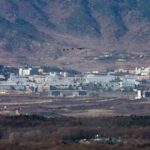
U.S. and South Korean authorities continue to advance the implementation of the U.S.-ROK Guidelines for Nuclear Deterrence and Nuclear Operations on the Korean Peninsula, recently signed by South Korean President Yoon Suk Yeol and U.S. President Joe Biden.
Following a tabletop exercise (TTX) that simulated North Korea’s use of nuclear weapons, high-level discussions at the Foreign and Defense Extended Deterrence Strategy Consultative Group (EDSCG) delved into the same scenario. Both nations are preparing for practical training based on new operational plans tailored to North Korea’s nuclear threats. The bilateral diplomatic and defense officials underscored that any use of nuclear weapons by Kim Jong Un’s regime would be met with a firm response.
The South Korean Department of Defense and the Department of State reported that U.S. and South Korean diplomatic and defense authorities held the fifth meeting of the Extended Deterrence Strategy Consultative Group (EDSCG) in Washington on Wednesday.
The meeting included discussions led by First Vice Minister of Foreign Affairs Kim Hong Kyun, Director of Defense Policy at the Ministry of National Defense Cho Chang Rae, U.S. Deputy Assistant Secretary for Arms Control and International Security Bonnie Jenkins, and U.S. Acting Deputy Under Secretary of Defense for Policy Cara Abercrombie.
Both nations reaffirmed their commitment to completely denuclearizing the Korean Peninsula during the meeting. They agreed to bolster deterrence against both nuclear and non-nuclear weapons of mass destruction from North Korea. Notably, this was the first time the EDSCG conducted a scenario-based discussion to enhance policy planning and collaboration, reaffirming their resolve to use all categories of military capabilities, including nuclear weapons, for South Korea’s extended deterrence.
They discussed at the EDSCG with assumed related scenarios given that the U.S. and South Korea plan to conduct various exercises assuming North Korea’s nuclear use.
Both sides reaffirmed that any nuclear attack by the DPRK against the ROK would be met with a swift, overwhelming, and decisive response, and the United States reiterated that any nuclear attack by the DPRK against the United States or its allies is unacceptable and will result in the end of that regime.
In response to a question about persistent calls in South Korea for Seoul to consider nuclear options to deal with evolving North Korean nuclear and missile threats, Jenkins emphasized the seriousness of the U.S. commitment to extended deterrence.
While Abercrombie remarked, “Any nuclear attack by the DPRK against the U.S. or its allies and partners is unacceptable and will result in the end of that regime.” She reaffirmed the U.S. goal of achieving the “complete denuclearization” of the Korean Peninsula while noting that Washington remains willing to engage in dialogue with the North “without preconditions.”
Discussion on North Korea’s Strategic Provocations: The 7th Nuclear Test and ICBM Launch
The U.S. and South Korea also discussed the potential for North Korean strategic provocations surrounding the U.S. presidential election.
Kim Hong Kyun noted, “Both U.S. and South Korean authorities acknowledge that we cannot entirely dismiss the possibility of North Korea launching significant provocations around the U.S. election.” He added, “We reviewed various potential provocations and discussed our responses.”
Cho Chang Rae added that the discussions included the possibility of North Korea conducting its seventh nuclear test or launching an intercontinental ballistic missile (ICBM). “We engaged in comprehensive talks today regarding these potential provocations,” he stated.
Deepening Connectivity Between the Indo-Pacific and Europe-Atlantic: Implications for U.S. Nuclear Posture
The U.S. and South Korea reaffirmed their commitment to engagement in the Indo-Pacific region through the EDSCG.
Under the Yoon Suk Yeol administration, the EDSCG has evolved to focus on the North Korean threat and broader security strategies impacting the Korean Peninsula and the Indo-Pacific region. This shift signifies a departure from the EDSCG’s initial sole focus on North Korea.
In this context, the two nations recognized the deepening connectivity between the Indo-Pacific and Europe-Atlantic regions and discussed its implications for deterrence and the U.S. nuclear posture.
As the U.S. and South Korea focus on Conventional Nuclear Integration (CNI), this suggests that they are changing their deterrence and nuclear posture to enhance their contributions to the Indo-Pacific region.















Most Commented